2008 Q&A
ArchiveUkulele History
& Vintage Ukuleles:
Questions, Answers, and
Information
2008
Archive
Click Here to
Ask a Question or Send Information
Date: July 1, 2008
Question:
Hi. I have a beautiful Harmony DeLuxe soprano ukulele made out of solid mahogany. It is obviously quite old, well made, and, judging by the scarcity of available information about it, pretty rare. I am having a very hard time finding out anything about it at all: its age, history, etc. Can you help me?
Answer:
That is a very nice ukulele you have. I have seen other Harmony ukuleles with some of the same characteristics, but I haven't seen another exactly like yours.
Your ukulele was made by The Harmony Company of Chicago Illinois. Harmony was owned by Sears, and manufactured many instruments for Sears under the Supertone (and later, Silvertone) brand names. The headstock shape on your ukulele is the shape they used on many of the Supertone instruments that were sold in the 1920s and possibly into the 1930s. For many years Harmony did not put its own name on the instruments they built. This changed in the late 1920s, when they began producing some better instruments with the Harmony name on them.
I would guess your ukulele was made in the late 1920s. It was probably one of their top-of-the-line instruments. It looks to be made of some very nice quality mahogany. The bridge on it is very unusual - I wonder if it could possibly be a replacement. I don't see any evidence of re-gluing, but I have never seen a tie bridge on a Harmony ukulele.
|  | 
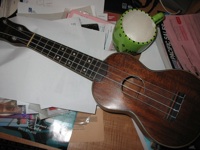

|

Date: July 1, 2008
Question:
Hello, I recently aquired this ukulele. It doesn't have any names, numbers or writing on it. Could please give any information? Was it made in Hawaii? Also, your take on types of woods used, espesially the top? Thanks.
Answer:
I'm quite sure that your ukulele was made by the Harmony company of Chicago, Illinois. It may well have been sold under the Supertone brand name by Sears Roebuck & Co. I would estimate that it was made in the 1920s . Harmony was owned by Sears at the time. Harmony's early ukuleles were made to look similar to Hawaiian ukuleles, and yours is a nice example of one of these. From the pictures I would say that your top is koa wood - the traditional Hawaiian ukulele wood.
|  | 
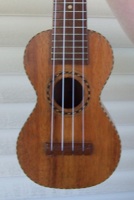

|

Date: July 1, 2008
Question:
Hey there! I aquired this ukulele a little over two years ago. It was left to me by my grandfather's uncle (a little shy of 101 years old) who was an antique collector. Unfortunately, this is all I know about it's history, save for the obvious. It is in quite good condition, although it sports a few scratches on the neck and body. I am anxious to see what you think!
Answer:
You have a very nice looking Style 2 ukulele manufactured by the CF Martin Co of Nazareth, Pennsylvania. It is made of mahogany. Based on the particular style of tuning pegs (manufactured by Kluson), I would estimate that it was made in the late 1940s or early 1950s. Martin ukuleles are considered by many to be the best ukuleles made, so they are desirable to players and collectors alike. It looks to be in very nice condition. At this time The Style 2 ukulele was one model from the top of the Martin ukulele line, above the Style 0 an Style 1, but below the "professional" model, the Style 3. They had already stopped producing their fanciest model, the Style 5K.
|  | 
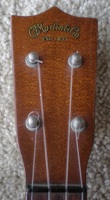
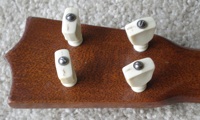
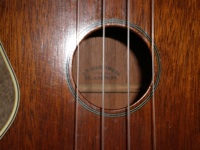
|

Date: July 1, 2008
Question:
Hi, great site. I recently bought this uke as a bit of project repair job. I know it's not one of the "classic" brands, but I'm curious and enthiastically refurbishing it in my spare time (yep it needs work). It says "Senorita genuine Hawaiian Ukulele" on the label, looks like it might be mahogany. Has bakelite tuner knobs, the seller tells me its from the 40's. A colleague tells me it looks like it might be a Martin copy from that period. Do you have any ideas on it's history or seen anything like it? Thanks for your time! Regards.
Answer:
That is an interesting label in your ukulele - I'm not sure that I have seen that one before. Senorita was a brand used on ukulele strings and also on banjos (by a few different companies), but I have never seen a Senorita ukulele before.
Your ukulele looks to have been made by the Harmony Company of Chicago, Illinois. I would estimate that your ukulele was made in the late 1920s or in the 1930s. The shape of the bridge on your ukulele is typical of Harmony ukuleles made in this time period. When I first saw the label photo I thought it was a more recent ukulele, but the "Standard Approved" mention makes me think it is older. The "Standard Approved" designation shows up on many Harmony-made ukuleles. This standard was created in 1927, and many Harmony ukuleles made for the next ten or so years had a special "Standard Approved" label inside the body. However, I have never seen a label like yours that mentions the "Standard" on the larger ukulele label. Thanks for sending the photos.
|  | 
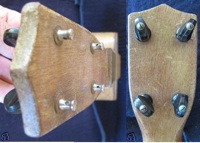
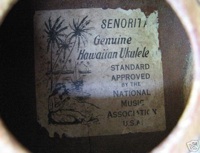
|

Date: July 1, 2008
Question:
I got this at a yard sale and I was impressed by the good tone, playability and quality of the wood. It is clearly quite old with the cloth case and friction fit wood tuning pegs. The label inside says "Ukulele Mfg. Co. Honolulu" and is applied over another label. I haven't tried to get underneath the label as I don't want to injure the upper label although it is loose on one corner. It has some damage to 2 cm. of the binding and a few cracks in the top but the back and sides are in very good shape. Do you have any clues as to age and maker? Thanks.
Answer:
That is an interesting ukulele you sent photos of - I actually happen to have a nearly identical ukulele. The Ukulele Manufacturing Company of Honolulu is a mystery. Extensive research in Honolulu directories of the late 1800s through the 1930s has found no evidence of such a company in Hawaii. Also, their ukuleles don't have many of the usual characteristics of Hawaiian-made instruments of the time period.
My personal opinion is that these ukuleles were made on the mainland, and passed off as "Hawaiian-made". They are nicely made and are made from Hawaiian koa-wood, but I don't think they were made in Hawaii. I would guess these were made in the teens or the early 1920s at the latest. I am very curious about the 2nd label you mention in your ukulele - this could help solve the mystery. So if you ever do pull back that top label, please let us know what it says underneath!
|  | 
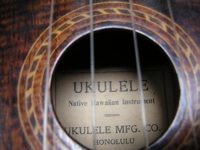
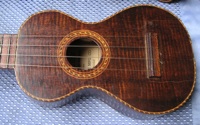
|

Date: July 1, 2008
Question:
Hello, A client dropped by with an inherited uke that they want information about. It is a Lyon & Healy made in Chicago. Headstock names/numbers are: Washburn, 711, Patent Applied For, TU-4. Any information would be appreciated. Thanks.
Answer:
You have a Lyon and Healy Washburn "tenor" model ukulele. L&H first listed "tenor" ukuleles in 1923-24 catalog. They were out of ukulele manufacturing altogether by 1929. The L&H tenor models are 24.5" in overall length. This is somewhere between what most people today call concert size (about 23" overall) and tenor size (about 26" overall). The Washburn name was used on L&H's top quality instruments.
Your ukulele is a model 711, the better of two tenor ukulele models listed in the 1923-24 Lyon and Healy catalog. This model of ukulele sold for $40 retail in 1924 - quite a bit of money for an ukulele at the time. The letters on the headstock read "TUA" not "TU-4".
The instrument appears to be in pretty good shape - I don't see any cracks in the photos (but there was no photo of the back). It appears to be all-original, including the tuners.
|  | 
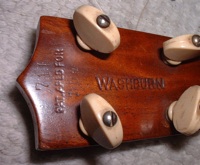
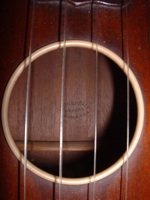
|

Date: July 1, 2008
Question:
I received this Regal (ID by decal remnant) with no strings or bridge. It has an arched top, and tailpiece: is this standard, and what shape/height of bridge would be a correct replacement?
Answer:
That's a very interesting ukulele that you sent photos of. I have seen plenty of Regal ukuleles, very, very few of which were archtops. Nearly all wood ukuleles have a bridge glued to the flat top (and no tailpiece). I assume your archtop had a floating bridge. Since I'm not very familiar with this style of ukulele, I can only guess what the bridge looked like. I would assume it was somewhat similar to a banjo ukulele bridge (basically like a banjo bridge but smaller). The feet of the bridge might need to be sanded to match the curvature of the top. The height of the bridge should be set to whatever height is needed to get the proper playing action for the strings. The bridge needs to be placed so it is as far from the 12th fret as the 12th fret is from the nut. If I had to guess, I would say your ukulele is probably from the 1930's.
|  | 
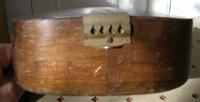
|

Date: July 1, 2008
Question:
Hi there, wonder whether you could help. I have just aquired a banjo ukulele I believe it was manufactured between 1930 to 1940 but cannot confirm this. Please see attached photos and could you help me please. I await your response with anticipation.
Answer:
It looks like your ukulele is a Hollywood brand banjo ukulele. I can't read the headstock decal, but it looks like the typical red stripe used by Hollywood. Hollywood was a brand name of Schireson Brothers, a music retailer in Los Angeles, CA. I don't have a detailed history of Schireson, but I know that they sold instruments by various makers but also manufactured instruments. From what I have seen of Hollywood ukuleles, they look like instruments from the later 20s or 1930s. I would assume your banjo ukulele would date to the same period. It looks like a nice quality banjo ukulele.
|  | 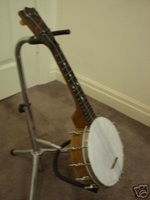
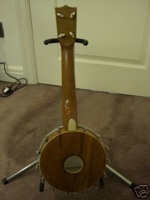
|

Date: July 1, 2008
Question:
Hi there, I just bought a Lyon & Healy Junior Camp Uke and am finding it hard to get any information on it. The man who sold it to me said it was from the 1920's which seems to fit with the wooden tuning pegs. It has a small circular body and the head reads "Uke Jr' - Lyon & Healy Makers Chicago USA". The inside of the body is inlaid with several diamond-shaped timber or plywood cutouts, which only cover from the centre to the right-hand side, or the bottom half when in playing position. It's had a fair crack in the soundboard which has at some stage been braced from behind in what looks to be a decent repair job, even if it's dampened the soundboard a little. The back is mildly warped, and the slit in one of the tuning pegs looks crushed shut, but otherwise it looks good.
I'm curious as to the age of this thing, which by my reckoning is in good but not great condition, certanly good for its age. Also wondering what the standard tuning would be on this tiny thing. The seller also assured me these ukes sound great and fairly loud despite their size, though it has no strings yet (I bought it the day after breaking my arm so I wont be playing it for a while, can't wait). It's an adorable little thing.
Answer:
Lyon and Healy made Camp ukuleles starting around 1921. I'm not exactly sure when they introduced the Uke Jr., but I would guess it was within a few years of introducing the Camp Uke. I do know they began selling them before 1925, because the 1925 Lyon and Healy catalog not only has them listed, it calls them "America's biggest selling low-priced ukulele". They sold for $2.40 retail at the time.
The Uke Jr. would have been tuned the same as a typical standard-sized ukulele, typically either GCEA or ADF#B. Lyon and Healy made good quality instruments, and although the Uke Jr. was their lowest priced model it was still a decent instrument. It sounds like yours has had some repair work done, but it may well still sound pretty good. The Lyon and Healy name makes it somewhat desirable, but it was an inexpensive instrument and not particularly rare.
|

Date: July 1, 2008
Question:
I recently inhereted this Martin and Co. Soprano Uke and would like to know which style/date it might be - It has tortoise shell binding, "CF Martin & Co. Nazareth PA" stamped inside - wood pegs - "Martin & Co. est 1833" decal on front of pegboard. Thank you for any information!
Answer:
You have a Martin Style 1 ukulele. It is made of mahogany and is soprano-sized. Soprano is the standard ukulele size, the smallest of four ukulele sizes produced by Martin.
Your ukulele has the unusual combination of wooden pegs and the Martin decal. The reason it is unusual is the Martin stopped using wooden pegs in the late 1920s, and didn't begin using decals (or tortoise-shell style binding) until the 1930s. I believe that Martin went back to wooden pegs during WWII, in order to conserve metal for the war effort. So it is my guess that your ukulele was produced between 1942 and 1945. It looks to be in great condition. Martin ukuleles are considered to be some of the best ukuleles made, and they are highly sought after by ukulele players. I hope you are planning to learn to play it!
|  | 


|

Date: July 1, 2008
Question:
My friend's mother just gave him this ukulele. I was hoping you could tell us a bit sbout it. Mahalo.
Answer:
Your friend has a nice looking Leonardo Nunes ukulele. Leonardo was a son of Manuel Nunes, one of the original ukulele makers in Hawaii. Leonardo left Hawaii in 1913 and opened shop in Los Angeles, Ca. Your ukulele appears to be from Leonardo's later period, I would guess it was made between 1925 and the early 1930s. The bridge pins and fretboard extension are somewhat unusual for Leonardo's instruments - most of his ukuleles are a plainer Hawaiian style. Leonardo Nunes ukuleles are good quality instruments that often sound great.
|  | 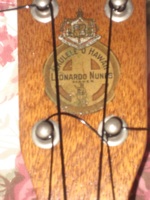
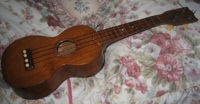

|

Date: July 1, 2008
Question:
Hi, ever seen one of these? It's the size of a standard soprano ukulele and actually plays very well. The neck is not bowed or twisted at all. The bridge is simply a block of wood, but it seems to be hardwood. The fretboard has a an inlaid centerline of lighter-colored wood about a quarter of an inch wide and a couple of dot markers of darker wood. Around the "bowl" or "resonator" there is a similar band of wood. As you can see, there are a couple of nice little f-holes opened up in the back. Workmanship actually looks pretty good. I'm not sure I'd say it was luthier-level work, but someone knew what he was doing and took some care to do a nice job. Could have been made in a factory or possibly from some kind of kit. Ever seen one before? I'm curious about how common this type of instrument might be. I've only had it home a couple of ho!urs, but it's really growing on me! I assume that a new set of strings would do it some good. Would it benefit from a better bridge? I would think this one might dampen the action of the top. Any info or opinions would be appreciated.
Answer:
I have seen quite a few banjo ukuleles like the one on your photos. As a matter of fact, the very first banjo-ukulele I ever owned was virtually the same model as yours. I am quite sure that this banjo ukulele model was manufactured by the Harmony Musical Instrument Company of Chicago Illinois. Harmony was one of, if not the, largest musical instrument manufacturer from the 1920s through the 1970s. They made mostly beginner and mid-range instruments.
Your banjo ukulele is probably from the 1920s or early 1930s. It wasn't an expensive instrument, but it is of a quality far above the cheapest instruments banjo ukuleles of the time. This is not an overly rare model, I am sure that Harmony made quite a few of them over the years. Still, being a relatively inexpensive instrument, many were probably thrown away over the years. The bridge on banjo ukuleles usually had small feet on either end, rather than the whole bridge resting on the head. So replacing your bridge might well improve it sound some.
|  | 


|

Date: July 1, 2008
Question:
To my untrained eye this Regal Ukulele looks structurally sound with some shallow nicks but the finish is less than perfect. Thanks again for sharing your knowledge.
Answer:
Your Regal ukulele looks like a very nice instrument.
The Regal Musical Instrument Company was founded in Chicago in 1908. They continued making fretted instruments into the early 1950s. Along with Harmony, Regal was one of the largest manufacturers of guitars and ukuleles from the 1930s to the 1950s.
I can't read the full label inside your ukulele from your photos, but I would guess that it says something about the "Regal Custom Shop". Regal's best instruments were labeled as being from its custom shop, and considering the high quality look of your ukulele I would guess it is one of these instruments. I don't the exact range of year's that Regal made these, although I have seen a 1937 music catalog that listed two "Custom Built" models. I would guess they were only made during the later 1930's and perhaps up to WWII.
|  | 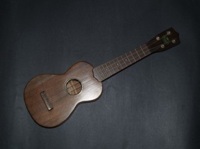
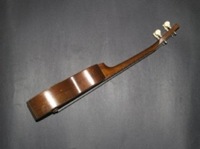
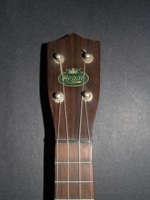
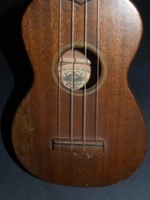
|

Date: July 1, 2008
Question:
Hi, please, could you certify my MARTIN Ukulele model ? Style 0, I suppose. And is it possible to date it? It is in very good shape, and sounds very, very well. I have just installed new chords. Best regards and thank-you.
Answer:
You have a very nice looking mahogany Martin Style 0 soprano. From your photos I would estimate that it was made anywhere from the mid 1950s to 1962 (after which Martin added "Made in U.S.A." to their soundhole stamp). It appears to be in excellent shape. These are considered excellent playing ukuleles - in general most people feel they sound just as good as any of Martin's fancier ukulele models.
|  | 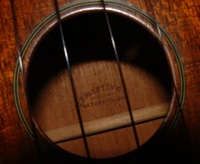

|

Date: July 1, 2008
Question:
I have 2 vintage ukuleles that I would like to know about. The first is a vintage Martin ukulele in good condition and I would like to know the model and approximate year. It seems to be a dark wood finish (mahogany?) It does have the decal on the front of the head, but is not stamped C.F.Martin & Co. Nazareth P.A. at back of tuning pegs.
The second appears to be a Kamaka & Sons Pineapple Uke with case. Thank you for your time and any info you can provide.
Answer:
You have two very nice ukuleles. The Martin ukulele is a Style 1C. The "C" is for concert. The Martin concert ukulele is a little larger than their standard soprano model (23" vs. 21" overall). Your Martin was made sometime between the mid 1930s and 1962. Based on the tuners on it I would guess that it is post WWII, so I would guess it was most likely made in the 1950s. Martin concert ukuleles are uncommon, and yours appears to be in excellent shape. They are highly sought after by players.
Your other ukulele is a Kamaka Pineapple model. It appears to have a white label, that and the style make me think it is from the 1970s. It looks like it is in great shape too, and has some very nice looking koa wood. It also appears to have a nice hard-shell pineapple case. This is typically a good playing ukulele and is desirable.
|  | 
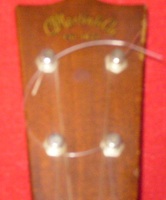
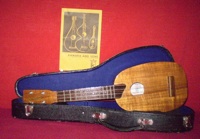
|

Date: July 1, 2008
Question:
Hello, I am French I ask a little tolerance on my English. I am looking for information on a ukulele I was presented as an Epiphone years 20.Je finds only label on the inside which seems too recent. The uke is a 2nd Oscar Schmit whom I do not know his age. Here is a photograph of the two ukuleles. I can provide additional photographs if necessary. Please help me if you can.
Answer:
Your English is a whole lot better than my French! I don't know too much about the Epiphone. The ukulele appears asian-made but is difficult to date. The label inside make me think 1980's or early 1990's, but I'm really not sure.
Your other ukulele was made by The Oscar Schmidt Co. The main Oscar Schmidt factory was located in Jersey City, NJ. They were a manufacturer of many different types of musical instruments including banjos, mandolins, guitars, ukuleles, and autoharps. They sold instruments under their own name, as well as under brand names such as Stella and Sovereign. Most of the instruments they manufactured were inexpensive to medium-grade instruments. The Oscar Schmidt company existed until the late 1930s when they were purchased by the Harmony company. In 1979 the name was purchased by Washburn. For the last few years, Washburn has been distributing a new line of ukuleles under the Oscar Schmidt brand name. Your ukulele was probably manufactured in the later 1920s or 1930s. It looks to be in nice condition
|  | 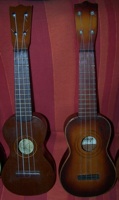
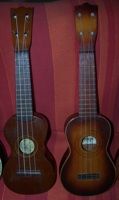
|

Date: July 1, 2008
Question:
Hello -I acquired this Wendall Hall Red Head ukulele and would like any information that you could give me. It appears to be in excellent condition, has a case and in the inside of the instrument is a label which says, "The Mele Ukulele" which has a scenic picture of a canoe. I look forward to your reply. Thank you.
Answer:
"The Mele" was a brand name used by Buegeleisen and Jacobson (B&J), a New York City based musical instrument distributor. They sold many types of ukuleles that were made by a number of different manufacturers, and they used the name "The Mele" on a wide range of instruments from these manufacturers. I would guess that most of the instruments that B&J sold with the "The Mele" label were manufactured by the big Chicago companies like Harmony and Regal.
The Wendell Hall Red Head ukulele was a product of the Regal company. Wendell Hall was a popular entertainer of the 1920s. His nickname was "The Red-Headed Music Maker". He had a big hit with "It Ain't Gonna Rain No More" in 1923. He played ukulele and tiple (a 10 stringed instrument tuned like an ukulele). I don't know the specific years of manufacture of the Red Head ukuleles, but I would guess they were mostly (and quite possibly only) sold in the 1930s. These were made from either some pretty fancy mahogany or koa wood (I think they are mahogany, but I have read others who claim they were made from koa wood, so I can;t say for sure). Yours does appear to be in very nice shape. It has a capo too (that metal thing at the base of the headstock). I wouldn't use the capo, as the spring tends to mar the neck.
|  | 
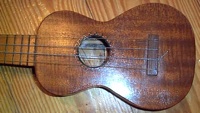
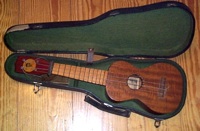
|

Date: July 1, 2008
Question:
Hi there. I recently acquired this old Silvertone ukulele. It seems to be in great condition. It has wooden friction pegs for tuners and a wooden fretboard. I\'ve been told that this uke was made by Harmony and sold by Sears. Most of the Harmonys I\'ve seen have plastic fretboards and tuners. I was hoping that you could shed some light as to how old this uke may be. Thanks!
Answer:
Silvertone was a brand name used by Sears. They started using the Silvertone name on instruments right around 1941. I am guessing that with the wood pegs on yours that it may have been made during the WWII period. I am speculating that with metal being in short supply during the war that companies went back to using wooden pegs for a few years. One way or another, your ukulele appears to be from the 1940s era. It was made by the Harmony Company, a company Sears owned until around 1941. Even after Harmony broke away from Sears, they continued to manufacture many instruments for them. Harmony started with the plastic fretboards in the 1950s I believe. It looks to be in great shape.
|  | 


|

Date: July 1, 2008
Question:
Greetings,I recently purchased this Gretsch Ukulele from an antique store. It's in very good shape and I am enjoying playing it. I have found a little about Gretsh on the internet but, was hoping you might be able to shed some more light. I am curious as to when this uke may have been made and what kind of wood it is made from? Gretsch American is stamped on the back of the head stock and inside of the body as you can see through the sound hole. Thank you for your time and expertise!
Answer:
You have a nice looking Gretsch American soprano ukulele. I don't know the exact history of the "Gretsch American" logo, but from the instruments that I have seen with the logo I would estimate that it was used in the 1920's and 1930's. I would guess that the vast majority (if not all) were made between 1925 - 1935. I feel that these older Gretsch ukuleles are far superior to the more common gold-logo Gretsch ukuleles of the 1950s. They are very well built and rival the instruments of other top ukulele makers including Martin, Gibson, and Favilla. From your photos I would say that your ukulele is mahogany, but I'd need to see larger photos to be sure.
|  | 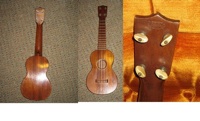
|

Date: July 1, 2008
Question:
My grandmother got this Uke recently and was told that it was made somewhere around 1924-27. Any information you could give me on it would be greatly appreciated. I have more pictures/different angles if it would be helpful. Thanks very much!
Answer:
That's a very nice looking Gibson ukulele you have. It is a model Uke-2. From what I have read, Gibson first made these ukuleles in 1927. They used the "The Gibson" logo on the headstock for a few years. They had changed over to "Gibson" by the early 1930's (at least by 1934). I don't know enough about Gibsons to give you a more specific date on yours. Personally, I prefer the early Gibson ukuleles (like yours) to those they made in the 1940's and 1950's. They made a very well-built and generally great sounding ukulele. Yours appears to be in excellent condition - I'll bet it sounds great.
|  | 
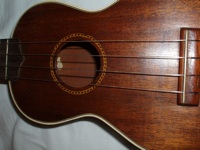
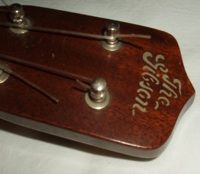
|

Date: July 1, 2008
Question:
Dear Sirs: I own a Ukulele that had to have been made before 1938. There is a tag inside stating that it was repaired in August 1938. The information tag inside states: "Ukulele O Hawaii / Jonah Kumalae / Made expressly for: / H.E. Weyman & Son / 1010 Chestnut Street / Philadelphia" PA and "Repaired by: / Clarence F. Stalcup / Violin Maker / August 1938 / Arcadia, California" There is also a written signature or something in ink on the paper tag inside the Ukulele.
Answer:
Your ukulele was manufactured in the factory of Jonah Kumalae, a Hawaiian businessman who owned a ukulele manufacturing company. Jonah Kumalae was one of the largest ukulele manufacturers in Hawaii during the first wave of ukulele popularity during the teens and 1920's. Kumalae started selling ukuleles in Honolulu in the years just before 1915. In 1915 his ukuleles won an award at the Pan-Pacific International Exposition in San Fransisco. Nearly every Kumalae ukulele made after 1915 mentions the PPIE 1915 award on the decal and or on the paper label. Kumalae's factory continued making ukuleles until Jonah's death in 1940.
Your label suggests to me that your ukulele was possibly made in the late teens or early 1920s. Like all Hawaiian-made koa wood ukuleles, Kumalae ukuleles are collectible. Because they were made in large quantities they don't usually command the prices of certain rarer makers.
Kumalae made many ukulele styles, mostly sopranos with a rather standard style sequence. Besides the standard sopranos, Kumalae also manufactured miniature ukuleles (referred to, in the period, as "midgets"), Concert-sized ukuleles, and 8-string Taropatches.
There is a range of styles (and values) in the "standard" Kumalae soprano line:
style 1 (or A): plain, no inlays except three thin rings around soundhole, penciled serial# inside with the letter "a"
style 2 (or B): rope inlay around soundhole, serial# with the letter "b"
style 3 (or C): rope inlay around soundhole and rope binding on the body, serial# with the letter "c"
style 4 (or D): rope inlay around soundhole and rope binding on the body and center of fretboard, serial# with a "d"
style 5 (or E): binding around soundhole, body, up center and edges of fretboard, serial# with the letter "e"
The value of your ukulele depends greatly on the style, the fanciness of the wood, and, of course, the condition.
|

Date: July 1, 2008
Question:
Very informative site...thank you for helping every one solve their Ukulele questions. I bought this Ukulele at a local Goodwill store and was wondering if you could give any additional information about it?
Answer:
Nice purchase! Your ukulele is a Martin Style 0. The decal on the headstock means it was made sometime after the early 1930s. The tuners appear to be the style that Martin used in the 1930s also (you'd need to send a view where I can see them from the side for me to be sure). As far as I know, Martin stopped using those tuners by around WWII. So I'd estimate your ukulele was made between 1932 and 1941 or thereabouts. It looks to be in very good condition. It also appears from the photos that it has metal strings on it. If so - I suggest getting rid of them immediately. These ukuleles were not intended for metal strings. Originally gut strings were used, and later nylon. The metal strings can do damage to the bridge, or worse yet the top could be damaged if too much tension is applied to them.
|  | 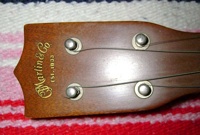

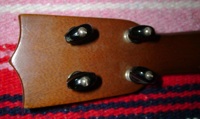
|

Date: July 1, 2008
Question:
Hello. There are no markings on this beautiful soprano ukulele except the label inside, which reads in green lettering "Genuine Koawood Ukulele, Material and Workmanship Guaranteed." Can you help me i.d. this ukulele? Make, age, etc. Any and all information would be great! It measures 21 in. total length, 9 1/8 in. body length, 5 in. across top body, 6 1/8 in. across lower body. Thank you.
Answer:
You have a nice looking koa wood ukulele. It is a mainland made ukulele, likely made by one of the many Chicago makers. It is made to resemble Hawaiian made ukuleles, with the rope binding and fanc headstock shape. I would guess that it is from the late teens or 1920s.
I have seen this model of ukulele and others from the same manufacturer with the same label. I even own two slightly less fancy versions by the same maker. However, I do not know the maker. I don't think it was Harmony or Regal, possibly the two biggest ukulele manufacturers of the time period. Although I have seen a number of similar ukuleles likely from the same maker, none has ever had a maker's mark of any sort.
It looks like the ukulele is in very nice condition with the exception of the chip off the bridge.
|  | 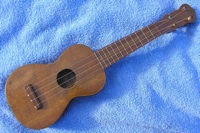
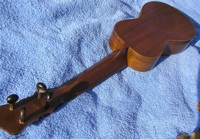
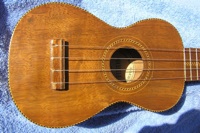
|

Date: July 1, 2008
Question:
This Uke was my father's, given to him by his father. I would like to know the model and approximate year. It is stamped "C.F. Martin & Co. Nazareth P.A." at back of tuning pegs and has the same brand stamped inside the sound hole.
Answer:
Your ukulele is an early model Martin Style 3. It is made of mahogany. Martin introduced these ukuleles in 1916. The earliest ones (1916 -1917?) had no fingerboard inlays. Around 1921 they stopped inlaying the diamond shape on the headstock, and changed the style of fretboard inlay on the 7th fret. Your has the "bow-tie" inlay, later models have two elongated diamonds on the seventh fret. Yours also has the earlier 5-7-9 fret markers, as opposed to the standard 5-7-10. The wooden tuning pegs were also used only on very early style 3s. I would estimate your ukulele to be from the very late teens.
Martin ukuleles are very popular with players and collectors and are quite valued. At the time your ukulele was made it was Martin's top-of-the-line instrument, and many consider Martin ukuleles to be among the best ukuleles ever made.
|  | 


|

Date: July 1, 2008
Question:
I am trying to locate a song by Perry Botkin Sr. that was released in the 1950's. Botkin was a fine guitarist and a fantastic ukulele stylist. The song I am looking for is called "Ukedoodle." If you have had the occasion to have heard it, you will probably agree that it is one of the most fantastic pieces of ukulele artistry ever recorded. I have never heard anyone do what he does on this song. Since it is so old I am having trouble finding a copy. So I thought that you folks here who are in touch with so many ukelele players might be able to locate a copy or tell me who to contact about it. I will really appreciate any help you care to give. Thanks much.
Answer:
I have heard of Botkin and his ukulele playing. I don't think I have ever heard of a song called "Ukedoodle" though. I do know of a Botkin song by the name of "Ukey Ukulele" - that was probably his best known ukulele recording. The only time I can recalling hearing the term "Ukedoodle" is as the name used on an early plastic toy ukulele sold by Mattel.
I do know that Perry Botkin's personal papers and many of his recordings are housed at the American Heritage Center at the University of Wyoming. I did a quick search of the extensive collection of his recordings, but I couldn't find "Ukedoodle" - though there is a copy of "Ukey Ukulele". Here is a link to the holdings...Perry Botkin Papers
Response from the original Question writer:
Very nice of you to reply to my rather obscure question. And you know what?...After all these years Ukedoodle just stuck in my mind as the title of that song. Seeing "Ukey Ukulele" set off a big memory jog. That's it! That is what I have been looking for all these years by the wrong title. No wonder I was having trouble. I will check the museum for further info. When I tried finding some info on Botkin onthe internet, I kept getting tons of info on Botkin's son, but not verymuch on him. I am in your debt. Thank you again...very much. |

Date: July 1, 2008
Question:
Gibson Ukulele. Any information would be helpful, found in a friends attic!
Answer:
You have a nice looking Tenor ukulele manufactured by the Gibson Co. of Kalamazoo Michigan. It is made of mahogany and the model number is the TU-1. From the looks of it, I would guess that it was made in the 1950s. It appears to be missing its bridge pins, but these can be replaced with guitar bridge pins available at most music stores.
|  | 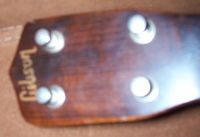
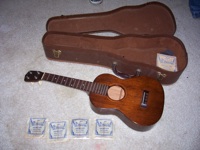

|

Date: July 1, 2008
Question:
Thank you for your efforts in trying to identify my neighbor's ukulele. It belonged to his grandmother who lived in San Francisco. He knows that she attended the Panama Exposition and he believes she bought it there. In looking at online histories, it appears identical to a photograph I saw of one by Jonah Kumalae with two exceptions: the headstock has only the seal and Hawaiian inscription; it has a paper label that reads: GUARANTEED GENUINE KOA MADE IN HAWAII BY THE NUUANU UKULELE CO. HONOLULU Based on his family information, this would appear to be an early Kumalae ukulele. Or, could the Nuuanu Ukulele Co. have been making copies of Kumalae's instruments? Thank you for any information you can provide.
Answer:
That's a very nice looking ukulele, thanks for the photos. I agree that it looks very much like ukuleles made in the Kumalae factory. The shape, the wood, and especially the particular style of rope inlay around the body all look like Kumalae.
There is a good bit of debate among ukulele historians as to whether Kumalae manufactured ukuleles for others to put their labels in. Some feel that Kumalae made large numbers of ukuleles sold under many other brand names. Others feel that if it doesn't say Kumalae anywhere on it, it wasn't made by Kumalae. My feeling is that the truth lies somewhere between these two extremes. I have seen just a couple of ukuleles that look just like Kumalaes but with other
names in them (I have one with an Enos Kealoha label inside). I believe there were at least a few instruments that came out of the Kumalae factory that were sold with other labels in them, and I wouldn;t be surprised if yours is one of them.
I doubt that your ukulele was purchased at the PPIE - it doesn't look quite that early to me. Kumalaes from the 1915 period have a bit of a different look than those made in the 1920s. Yours looks more like a 1920s era instrument to me.
The Nuuanu ukulele company is a bit of a mystery - they are not listed in the Honolulu directories of the time. I have seen other Nuuanu labeled ukuleles that were Hawaiian but didn't resemble Kumalae instruments. I wouldn't doubt if they sold instruments made by various manufacturers.
|  | 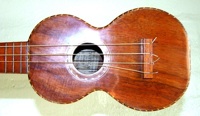
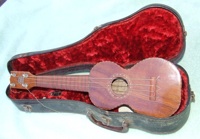

|

Date: July 1, 2008
Question:
Hi. I bought this ukulele at a second hand store. I find nothing indicating its make or year. When I bought it, it had one string, two round tuning tension pegs, also two mismatched - all made of wood. The inlay around the sound hole is nice to look at. The guitar seems to be mahogany. My reason for your knowledge is when I plucked the only string on this, it had such depth, I felt I might have something special. Thanks in advance for any help you can give me on this matter.
Answer:
I believe that your ukulele was made by the Harmony Co. of Chicago, Illinois in the late teens or 1920s. At the time, Harmony was owned by Sears, and produced many (or possibly all) of the ukuleles sold by Sears under the Supertone brand name. Harmony also sold instruments to other musical instrument dealers around the country. Your ukulele looks exactly like a Supertone model that was offered by Sears during the 1920s. The headstock shape is distinctive to the Harmony company. Until the late 1920s Harmony did not generally put its own name in the instruments it manufactured. Instead the particular retailer would put in its own label.
Your ukulele may well have had a paper label in it at one time. It most likely was sold by Sears as a Supertone, but it is possible it was sold through a different retailer. The bridge on your ukulele looks to have been replaced, as it is a different style than those typically used at the time. The Harmony Supertones were not overly expensive instruments, but they were built well of solid woods and often sound quite good. I hope you are enjoying yours.
|  | 

|

Date: July 1, 2008
Question:
Martin ukulele 1950? Hello, what do you think about it? Thanks
Answer:
I assume you are asking if I agree that this Martin ukulele is from around 1950? Actually, I would have guessed a little earlier. The tuning pegs on the ukulele look pre-WWII to me. That combined with the decal on the front suggest to me that it is from the late 1930s or thereabouts. It is a Martin Style 0, their plainest model. As you pointed out in the photo there are a few cracks that need to be repaired. If you get those repaired you should have a very nice sounding ukulele - enjoy it.
|  | 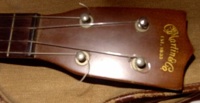


|

Date: July 1, 2008
Question:
I have a vintage ukelele, presumably Koa, and from the 20's or 30's; paper label inside says The Mele, New York. Can find no info about the maker. I was thinking that the ukelele looked similar to Martin or Harmony ones I have seen. I've attached some pictures, perhaps they will help you to identify it. I'm basically curious as to whether it qualifies as a "toy" or more. Can you help? Thanks!
Answer:
"The Mele" was a brand name used by Buegeleisen and Jacobson (B&J), a New York City based musical instrument distributor. They sold many types of ukuleles that were made by a number of different manufacturers, and they used the name "The Mele" on a wide range of instruments from these manufacturers. From those that I have seen, I believe most of the instruments that B&J sold with the "The Mele" label were manufactured by the big Chicago companies like Harmony and Regal. Although most "The Mele" ukuleles I have seen are mid-range instruments, I have seen at least one Martin ukulele sold through B&J with the Mele label.
Based on your photos, your ukulele appears to be a product of the Harmony Musical Instrument Co. of Chicago, Illinois. That headstock shape is the typical headstock seen on many Supertone instruments made by Harmony and sold through Sears. It was also used on other Harmony instruments sold through other distributors, such as your ukulele. I would estimate yours was made between the late teens and 1926 or so.
Your ukulele was not manufactured as a professional instrument, yet it was more than a toy. The rope inlay on the body and up the center of the neck suggest this was probably one of Harmony's fancier models at the time it was sold.
|  | 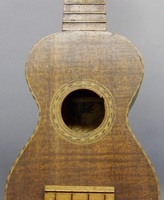
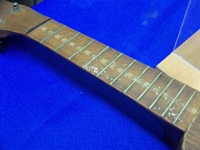
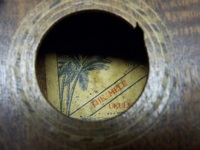
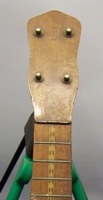
|

Date: July 1, 2008
Question:
I have a aloha ukulele a soprano model,the peg head has aloha on a banner at the top a coat of arms with what looks like Hawaiian writing underneath and the word Hawaii beneath that. On the inside back of the instrument under the sound is what looks like crossed paddles with the words "Tabu Made in Hawaii" and the word Akai in large written letters under that. All the above look as if they have been burnt on. Further down on the inside back is the number 143 written in what looks like crayon. It is the same model as one my late father purchased when he was in Hawaii with the navy during the 1939-1945 war years. I purchased the ukulele at an auction some years ago. It is in as new condition and does not appear to have been used it is complete with its original bottom opening case with a leather handle. Any information on its history and age would be appreciated. Regards.
Answer:
The Akai brand was used by the Aloha Ukulele Manufacturing company. The company was listed in the Honolulu directories from 1918 to 1930, which was the heyday of Hawaiian ukulele manufacturing. I would guess that your ukulele was made during that time period. According to research done by John King, Akai was the pseudonym for the builder Tai Chong Goo.
Aloha was one of the major Hawaiian ukulele manufacturers of the time period. They made a pretty wide range of styles, all from Hawaiian koa wood. The fancier models featured inlays and "rope" binding around the top. The fanciest had the binding on the fretboard and headstock also and sometimes featured shell inlay.
The Tabu stamp was a trademark of the Honolulu Ad Club. It was used by a number of different Hawaiian ukulele manufactures from 1916 until at least the 1930s. The stamp was intended to distinguish Hawaiian-made instruments from those manufactured on the mainland.
|

Date: July 1, 2008
Question:
I inherited this rather beat-up ukulele from my uncle many years ago. I am now passing it to my son-in-law (an avid ukulele player) to be restored. I would like to know if it was manufactured by Favilla. I could not find anything on a "Mannie" model of Ukulele, but inside the body there are two paper tags; one with "S. Selig - an agent for Favilla String instruments" and the other directly underneath with an eagle emblem and the words "Marca Aquila." Can you identify this poor specimen? Do you know when and where it was manufactured? Thanks for your help.
Answer:
That is a very interesting ukulele that you have. I have every reason to believe that this was made by Favilla. From examples I have seen, i believe The "Marca Aquila" label was used by Favilla in the later teens and the 1920s. Your ukulele is a very unusual model, apparently custom-made. It is somewhat similar to the Favilla model No. 6U (see the 4th image at right), which was their "De Luxe" model. This model had a bound fretboard like yours, but was made with mahogany throughout. In contrast, the top of your ukulele appears to be a type of spruce and the back appears to be made from curly maple. Like your instrument, the "De Luxe" model also had "two piece back with center strip of fine marqueterie" (as quoted from an original advertisement circa 1930).
I would guess that "Mannie" ordered the ukulele from Favilla, possibly choosing the wood and specific inlay pattern on the headstock. There is a decoration on the bottom front of your uke that is completely out of the ordinary for a Favilla uke. This to, I would think, is also likely a custom addition. My best guess is that this is a custom instrument made by the Favilla Company of Brooklyn in the 1920s or early 1930s.
|  | 
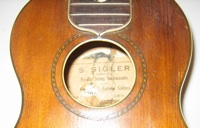
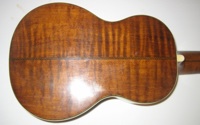
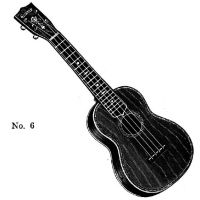
|

Date: June 30, 2008
Question:
I've attached 3 pictures. Please note: in the picture of the backside of the ukulele, the wood appears to be very dark. But in real life, that wood is exactly the same color & grain as the front side of the instrument.This Regal ukulele belonged to my Dad. It's been in my possession since his death in 2001. I thought it was a toy, but I have been displaying it proudly in my home because it reminds me of my Dad. For some reason today, I picked it up desiring to know more...and happened across your website. Would you please tell me as much as you can about it? I'd like to learn how to play it; am having a difficult time keeping it tuned...afraid to put too much pressure on the screws. Any suggestions?
Answer:
That's wonderful that you have your father's ukulele. Regal was one of the big Chicago-based musical instrument manufacturers. They made many ukuleles from the 1920s through the 1950s. Your ukulele appears to be from the later part of that range, it is probably from the 1940s or 1950s. It appears to be painted a brown color - if it is a brown paint, then the body and neck are probably made from birch.
Your Regal should make a nice instrument on which to learn to play. I wouldn't worry too much about putting too much pressure on the screws - they should be able to handle it. If the pegs still don't hold after the screws are tightened, you could replace them. Regal made mostly inexpensive instruments, but still some can sound quite good. Yours is typical of one of their beginner models.
|  | 
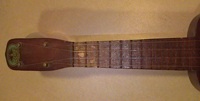

|

Date: June 30th, 2008
Question:
I recently came by an S.S. Stewart Soprano Ukelele and know nothing about them. I am familiar with Stewart as a manufacturer of high quality banjos around the turn of the century and understand that they made, or at least distributed some ukes under their name later on. The one I have appears to be mahogany all the way around. The tuning pegs are wood with pearl dots in the end of them and it came with what is likely the original case. What kind of info can you give me about Stewart ukes in general, and the one I have, from my description? I don't have any pics I can send at the moment.
Answer:
As you said, S.S. Stewart was a manufacturer of high quality banjos around the turn of the century. However, the S.S. Stewart trade name was sold around 1915 to Buegeleisen and Jacobson (B&J), a New York City based musical instrument distributor. They sold many types of ukuleles that were made from a number of different manufacturers, and they used the name S.S.Stewart primarily on the higher-end (for them, anyway) instruments from these manufacturers. At various times, the S.S. Stewart name was used on instruments made by Martin, Gibson, Turturro, and Regal. We have seen pearl dots on the wooden tuning pegs of at least a few Turturro instruments. If you send a few images, we might be able to tell you the actual manufacturer.
|

Date: January 12th, 2008
Question:
Can you help me date this Ukulele? It appears to be a Kamaka but the fingerboard is different than most of the ones that I have seen (bottom of fingerboard is not straight but curved - see picture). There is a very shiny gold label inside the hole reading "Kamaka". The Uke has been in our family for many years but no one can help date it. The person who originally owned it died in the early 1990s. He was in Hawaii in the Navy in the 1940s or 1950s. Could it possibly be from that time frame? It has been stored inside a hard case so it is in pristine condition. However, I live in Arizona and I understand the dry climate may also effect it. I would appreciate any help or information you can provide.
Answer:
Your ukulele is a genuine Kamaka. The fingerboard extension is one of the variations that Kamaka used on their ukuleles. I don't know for sure but I would guess they used that extension during the 1960s and 1970s. Kamaka used the gold label from about 1954 to 1969, so that gives you the approximate age of your instrument. If I had to guess based on its appearance, I would say your ukulele is from the mid to later 1960s.
The dry climate in Arizona could be a bit of a problem - if the wood dries out it would be susceptible to cracking. There are companies that make little humidifiers that you can keep in the case that help prevent such problems.
|  | 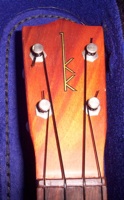
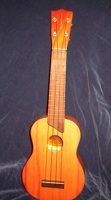
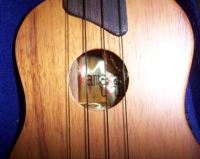
|

Date: January 4, 2008
Question:
We have a vintage Martin uke in excellent condition and would like to know the model and approx year. It seems to be a dark wood finish (mahogony?) It does not have decals but is stamped C.F.Martin & Co. Nazareth P.A. at back of tuning pegs. Also has the same brand stamped inside the sound hole. The inlay markings on the fretboard seem different to most other Martins we have seen in pictures.
Answer:
You have a very interesting Martin ukulele. It is a mahogany style 3 soprano but it has unusual fretboard inlays. It appears to be from the 1920s or 30s. The unusual thing about the uke is the fretboard markers, especially on fret 7. The standard Martin style 3 ukuleles from this time period had unslotted diamond at frets 5 and 10 and elongated diamonds at fret 7. Although some style 3s have slotted diamonds, I have never seen the "elongated football" shaped inlays like those on your seventh fret.
The "Made in USA" stamp at the top of the back of the headstock indicates that the instrument was made to be exported.
Martin style-3 ukes are highly valued by players and collectors alike. The inlays on your uke make it unusual, but I don't think they would change its value substantially.
|  | 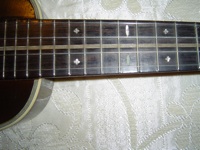
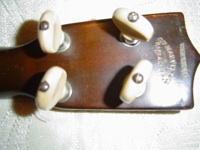
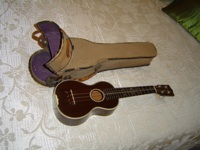
|

Date: January 4, 2008
Question:
I spoke with my uncle (78 yrs old) and he always recalled this to be an item of my grandmothers (born 1911). Upon that revelation I do recall her playing it during some holidays. It was later given to my mother and she actually took up playing for a while. That mostly occurred before I was born. I don't have any other knowledge at this point. My Aunt will be visiting soon, perhaps she will have a story to add.
I really hope that the photos can tell you something.. I just have always enjoyed having it about.
Answer:
Thanks for writing and for the photos.
Your ukulele appears to be a nice Hawaiian-made instrument, probably manufactured in the late teens or 1920s. It looks to be made from Hawaiian koa wood. From the looks of it, I would guess that the bridge and the tuning pegs have both been replaced. The tuners were probably originally wooden friction tuners. The bridge is just a little different than the typical Hawaiian style bridge. I would guess both were replaced long ago.There were many people in Hawaii making very similar instruments in this time period, so it would be very difficult to name the specific maker without a label or decal of some sort. I doubt very much that the mark beneath the bridge is a maker's mark. I would guess that this mark would have been added by a former owner of the instrument - is it possible that it could be your grandmother's initials or something of the sort? Anyway, I hope this helps. Let me know if you have any other questions.
|  | 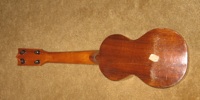
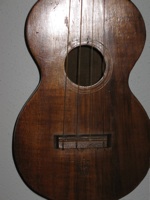
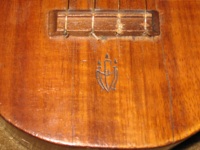
|
 |




































